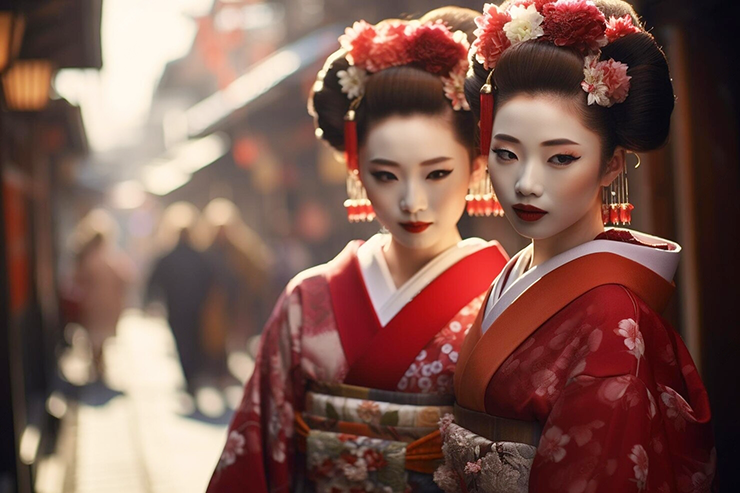
Japan’s rich cultural heritage is epitomized by the artistry of Maiko and Geiko (Geisha). While both represent elegance and tradition, they possess unique traits that distinguish them in appearance and role. This article explores who they are, the meaning behind their titles, and the differences in their clothing, hairstyles, and makeup.
What is a Maiko?
A Maiko is an apprentice Geisha, primarily found in Kyoto, undergoing intensive training in traditional Japanese arts such as dance, music, and tea ceremony. Aged between 15 and 20, Maiko embody youthful energy and vibrant charm. They are in the process of mastering the refined skills required to entertain guests at tea houses, or ochaya, with their artistry.
The term Maiko translates to “dancing child” (舞子), highlighting their role in performing traditional dances. Their attire and presentation vividly reflect their apprenticeship, with ornate and colorful elements that emphasize youth and vitality.
What is a Geiko (Geisha)?
A Geiko—the Kyoto term for Geisha—is a fully trained professional artist and entertainer. Geiko have completed years of rigorous apprenticeship and have honed their skills in conversation, music, and dance. Unlike Maiko, Geiko exude maturity, poise, and understated elegance.
The word Geisha (芸者), often used outside Kyoto, means “person of art” and underscores their role as cultural and artistic custodians. Geiko are revered for their grace and ability to maintain traditional Japanese customs.
Differences Between Maiko and Geiko
Although Maiko and Geiko share similar training paths, their appearances and roles differ significantly.
1. Clothing Style
Maiko:
Maiko wear elaborately designed furisode (long-sleeved kimono) with vibrant colors and intricate patterns. These kimonos feature long obi (sashes) that trail down their backs, symbolizing their apprentice status. Their collars are red with white embroidery, signifying youth and energy.
Geiko:
Geiko attire is more subdued, reflecting their maturity. They wear hikizuri, a more restrained kimono style with shorter sleeves and less vivid patterns. Their collars are entirely white, showcasing their professional status and sophistication. The obi is tied shorter and more discreetly.
2. Hairstyle
Maiko:
Maiko hairstyles are elaborate and adorned with colorful hairpins and ornaments called kanzashi. These styles change as they progress in their training, with iconic looks like the wareshinobu and ofuku. Maiko use their natural hair for these styles, which require daily care and maintenance.
Geiko:
Geiko, in contrast, wear simple wigs called katsura. These wigs are styled in a sleek and elegant shimada style, reflecting their professional standing. Their minimal hair accessories enhance their understated look.
3. Makeup
Maiko:
Maiko’s makeup is striking, with a completely white-painted face, vivid red lips, and accentuated eyes. Their eyebrows are drawn higher, and they leave a bare strip of skin at the nape of the neck for an alluring effect. Maiko’s makeup symbolizes youthful exuberance.
Geiko:
Geiko wear lighter makeup compared to Maiko. Their faces are still painted white for performances, but their everyday appearance is more natural. Mature Geiko often forgo the bold eye accents and red lips in favor of understated beauty.
4. Accessories
Maiko:
Maiko footwear includes okobo, tall wooden sandals that add to their youthful appearance. Their accessories, from ornate kanzashi to flowing obi, are designed to captivate attention.
Geiko:
Geiko wear lower wooden sandals called geta. Their accessories are minimal, focusing on refined elegance rather than vivid ornamentation.
The Transition from Maiko to Geiko
The transition from Maiko to Geiko is a ceremonial event called erikae (turning of the collar). During this event, the Maiko replaces her red-embroidered collar with a plain white one, marking her official status as a Geiko. This shift also brings changes in her attire, hairstyle, and makeup to reflect her maturity and professional expertise.
The Maiko and Geiko are living embodiments of Japan’s cultural artistry. While Maiko charm audiences with their youthful vibrancy and elaborate presentation, Geiko captivate with their refined elegance and mastery of tradition. Their differences in clothing, hairstyles, and makeup signify the transition from enthusiastic apprentice to accomplished professional, weaving a timeless narrative of dedication and grace.
The post Maiko vs. Geiko: Unveiling Japan’s Timeless Elegance appeared first on The Fashiongton Post.
